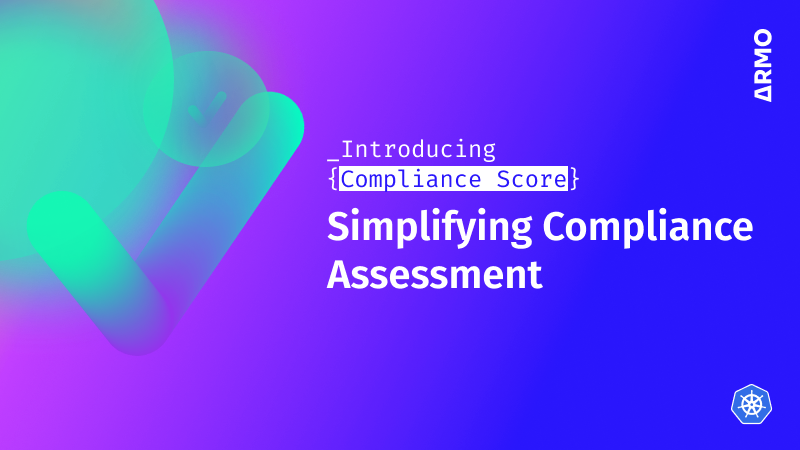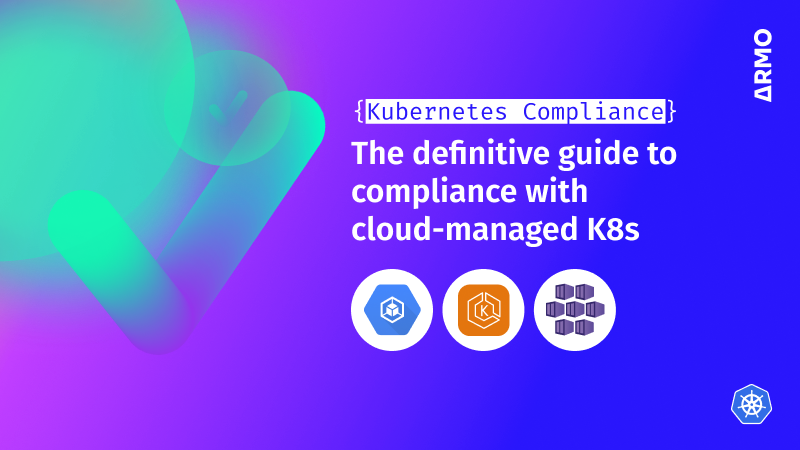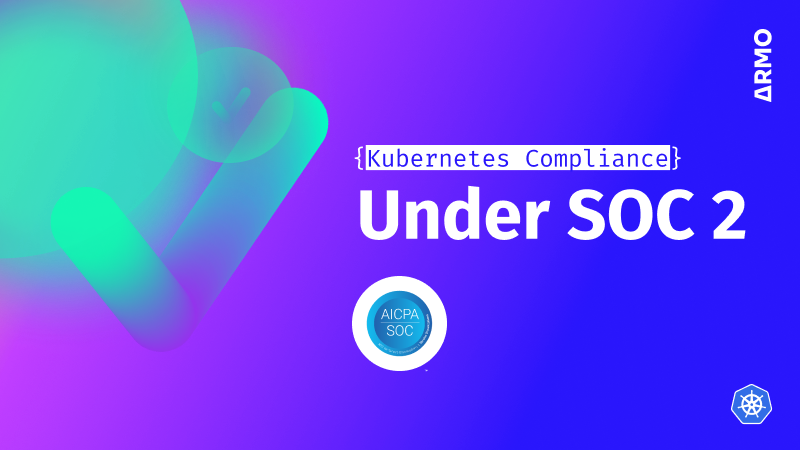Introducing Compliance Score: simplifying compliance assessment
Improve Kubernetes compliance with ARMO Platform's user-friendly Compliance Score for enhanced security. Click here to...

Jun 15, 2023
Learn about Kubernetes compliance challenges, consequences of non-compliance, and get guidance on maintaining a secure and compliant cloud environment in a dynamic Kubernetes setup. Originally posted on March 15, 2023
Kubernetes is a leading open-source platform for automating containerized applications’ deployment, scaling, and management. With the growing adoption of cloud, hybrid, and multicloud environments, the topic of Kubernetes compliance has become increasingly pertinent. Kubernetes compliance means ensuring that the platform and its components adhere to applicable regulations and standards. With a rapidly growing attack surface in modern cloud environments, the emphasis on compliance has increased among Kubernetes users.
This post will explain what compliance is in Kubernetes, the challenges of achieving it, and the consequences of non-compliance. It will then explore how to achieve compliance in this dynamic, ephemeral environment. You will gain insights, guidance, and tool recommendations to help maintain a secure and compliant Kubernetes infrastructure.
Understanding compliance in Kubernetes
Compliance in Kubernetes applies to various aspects of the platform, including security, data privacy, network security, and incident response. The goal of Kubernetes’ compliance requirements is to minimize the risk of security breaches and ensure that sensitive data is protected. This section will present the leading regulatory frameworks and standards that apply to Kubernetes in specific contexts, and discuss the significance of the Kubernetes attack surface.

Several regulatory frameworks and standards apply to Kubernetes, depending on the industry and location of the organization. Some examples include:
The attack surface of Kubernetes refers to the various areas of a Kubernetes cluster that are vulnerable to an attack. These areas, or attack surfaces, can be grouped as follows:
As Kubernetes adoption has grown, so have new use cases which drive more complex architectures This level of adoption has also increased the attack surface of Kubernetes clusters and led to it becoming more diverse and harder to control. This is the direct result of increasing numbers of Kubernetes clusters being deployed in multicloud and hybrid-cloud environments. Thus, organizations must implement robust security controls and continuous monitoring in order to protect their Kubernetes stack from potential attacks.
Compliance frameworks play a crucial role in securing Kubernetes clusters. These frameworks provide guidelines and best practices that help organizations establish robust security controls and ensure adherence to industry regulations. By following compliance frameworks, organizations can implement essential security measures, such as access controls, network policies, and data encryption, to protect sensitive information and prevent unauthorized access. However, achieving compliance in Kubernetes can be quite challenging due to its dynamic and distributed nature. The inherent complexity of Kubernetes, with its multitude of components and the need to manage configurations and updates across clusters, adds an additional layer of difficulty to ensuring compliance. Nevertheless, organizations must rise to the challenge and invest in robust compliance strategies to effectively secure their Kubernetes clusters and maintain regulatory standards.
Compliance in Kubernetes is a complex beast, due to the architectural characteristics of the cloud and the limitations of current compliance tools. This section will first discuss difficulties related to the dynamic and ephemeral features of Kubernetes and then look at existing compliance tools’ limitations, before suggesting ways to overcome these limitations.
Achieving compliance in a dynamic, ephemeral environment such as Kubernetes can be challenging for a number of reasons, which deserve a closer look.
Kubernetes clusters are commonly used for complex applications that use microservices. Their architectural complexity makes compliance across the entire environment a challenge; there are often multiple interconnected components to consider.
Pods and containers in a Kubernetes cluster are ephemeral, meaning that they are typically created and destroyed quickly and frequently. This transient state makes it challenging to maintain consistent compliance across the entire stack, as resources may be added or removed without proper oversight.
Kubernetes creates a complex stack with applications running both in the cluster and in the underlying cloud infrastructure. There are widely adopted tools available to improve visibility, such as Prometheus for monitoring, Grafana for visualization, and initiatives such as OpenTelemetry to create a unified platform. However, these tools are limited in terms of their focus, and creating holistic visibility often remains elusive. This creates challenges in identifying and addressing compliance issues in a timely manner.
One of the critical features of Kubernetes is its ability to scale resources automatically based on demand. Although it is a compelling feature, finding security issues in a thousand-node production environment is challenging.
While Kubernetes poses several compliance challenges, the platform actively fosters collaboration with a vibrant, open-source community, and stays attuned to industry trends. It’s reasonable to assume that in the coming years, compliance management for Kubernetes will be improved and simplified. Current compliance solutions in the Kubernetes ecosystem have several limitations, including a lack of Kubernetes-specific features, limited automation, and restricted integration.
Many compliance solutions are designed for traditional cloud infrastructure environments. As a result, their capacity to address Kubernetes-native features—such as extensions with custom resources or RBAC controls—is limited.
Compliance solutions that rely on manual inspections and audits to ensure compliance can prove to be time-consuming and error-prone. In an ephemeral environment such as Kubernetes they can also prove to be futile. In addition, without automation and continuous controls, ensuring compliance in Kubernetes is onerous.
Some compliance solutions may be siloed and integrate poorly with other tools and systems used in the Kubernetes ecosystem., This lack of integration between monitoring, logging, auditing, and node-level container runtimes tools may result in suboptimal visibility and can slow down identification of security breaches and patching of them.
In order to overcome these limitations, organizations should adopt compliance solutions designed explicitly for Kubernetes environments. These solutions should include features such as automated compliance checks, Kubernetes-specific auditing, and integration with other tools and systems used in the Kubernetes ecosystem.
Please note that relying on compliance tools designed for a cloud environment does not guarantee a sufficient feature set to ensure Kubernetes cluster compliance.
Here are three important things to consider when looking for ways to ensure compliance in a dynamic, complex Kubernetes environment:
As opposed to a single solution, it is recommended to deploy a number of tools that should be integrated into your overall compliance framework:
| Category | Solution Providers |
| Code compliance | OPA, Kube-compliance, Kubescape |
| Admission controllers | Built-in Kubernetes feature, Kyverno, Gatekeeper |
| Auditing & logging | Elasticsearch, logstash, Kibana, Fluentd, Prometheus |
| Image scanning | Trivy, Clair, Kubescape |
| Networking | Calico, Cillium, Istio |
In addition to selecting the most effective tools, ensuring best practices is also an important part of maintaining Kubernetes security:
Non-compliance in a Kubernetes environment can create avoidable risks and lead to serious consequences, including:
To mitigate these risks and consequences, organizations should adopt a comprehensive compliance strategy that includes regular audits, automated compliance checks, and ongoing monitoring of the Kubernetes environment.
Compliance in a Kubernetes environment is a complex and ongoing process. The dynamic and ephemeral nature of clusters, combined with the growing attack surface in modern cloud environments, makes it challenging to maintain a consistent state of compliance. Despite these challenges, organizations must ensure compliance in order to minimize the risk of security breaches and protect sensitive data. This requires a comprehensive approach involving continuous monitoring and assessment, automated testing and remediation, and regular updates to policies and procedures.
In light of these challenges, it is crucial to prioritize compliance in a Kubernetes environment and invest in the necessary resources and tools to maintain high compliance standards. This means staying up to date with the latest regulatory requirements and best practices, and adopting solutions that can help automate the compliance process. ARMO Platform, powered by Kubescape, is a Kubernetes-focused, comprehensive solution to manage compliance in any Kubernetes environment. Sign up today to secure your Kubernetes environment and stay ahead of regulatory requirements.

The only runtime-driven, open-source first, cloud security platform:
Continuously minimizes cloud attack surface
Secures your registries, clusters and images
Protects your on-prem and cloud workloads

Improve Kubernetes compliance with ARMO Platform's user-friendly Compliance Score for enhanced security. Click here to...

Master Kubernetes compliance with cloud providers for a secure infrastructure through certifications, security features, and...

This post discusses the five Trust Services Criteria (TSC) of SOC 2 and how they...